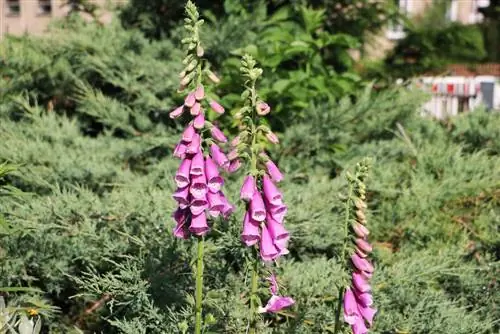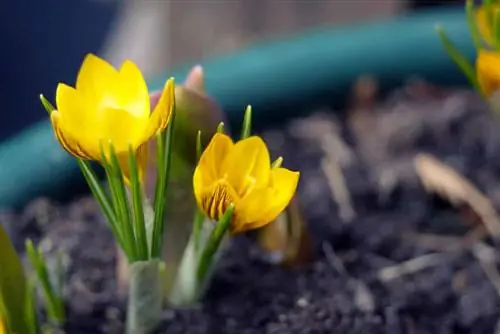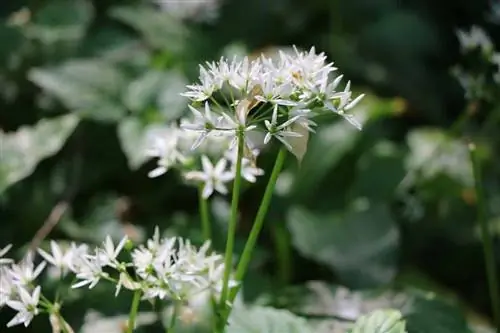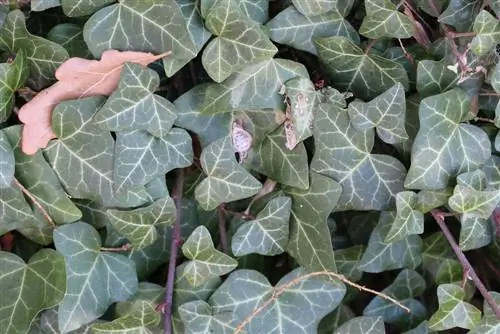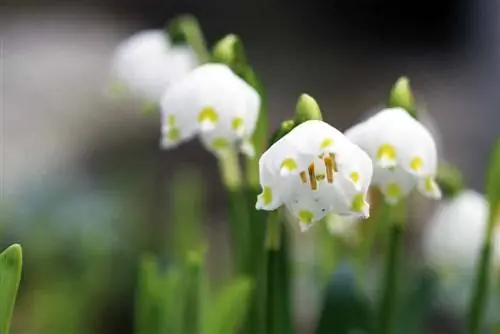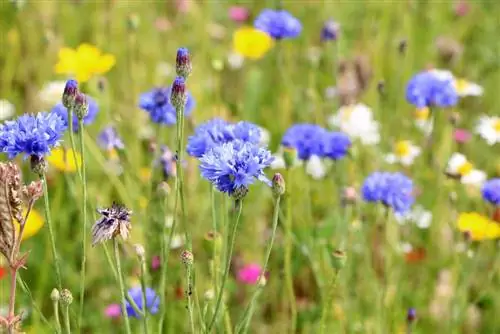- Author admin [email protected].
- Public 2023-12-17 03:39.
- Last modified 2025-01-24 12:45.
Germany is located in the temperate climate zone of Europe and has a diverse flora that adorns forests and meadows with a true play of colors. The forest flowers in the local areas provide a unique view of the diversity that nature offers. If you are interested in the forest flowers of Germany, you can easily recognize them by their bright colors.
What colors are there?
Anyone who spent part of their childhood in the forest will have no problem identifying many of the flowers that can be found in the undergrowth and on the edge of the forest. The German flora focuses on a small selection of colors that are original and, in contrast to tropical plants, appear rather simple. Forest flowers bloom in the following colors:
- white
- greenish
- blue and purple
- reddish
- yellow
- multicolored
Tip:
When identifying a flower, don't just rely on the color. Patterns on the leaves, the shape of the flowers and the growth provide further information about which plant it could be.
Forest flowers in white
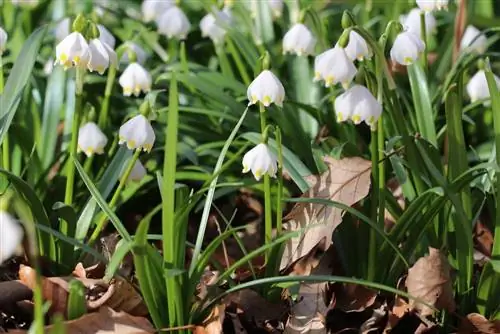
The local forests have a tendency to have white flowers that stretch towards the sun between the green undergrowth to greet hikers and nature lovers with their floral decorations. In addition to the yellow flowers, they form the largest group and are very popular because of their color. What is striking about the white forest flowers are the numerous flowers, which can be found on the plants in a wide variety of shapes and from magnificent umbels to panicles, like the foam flowers. They stand out very much from their green leaves and are often worn as hair accessories. Some of the species, including lily of the valley, woodruff and wild garlic, are among the best-known plants that are mainly found in spring. The woodruff is even one of the first plants that can be found in the forest in spring and has been used by people for thousands of years.
The following forest flowers bloom in white:
- Gedweed (Aegopodium podagraria)
- Garlic mustard (Alliaria petiolata)
- Wild garlic (Allium ursinum)
- Wood anemone (Anemone nemorosa)
- Forest foamweed (Cardamine flexuosa)
- Meadow foamweed (Cardamine pratensis)
- Lily of the valley (Convallaria majalis)
- Forest strawberry (Fragaria vesca)
- Wood sorrel (Oxalis acetosella)
- Forest goat's beard (Aruncus dioicus)
- Immenblatt (Melittis melissophyllum)
- Woodruff (Galium odoratum)
- Little Beavernelle (Pimpinella saxifraga)
- Foam flowers (Tiarella)
- Great Witchweed (Circaea lutetiana)
- Märzenbecher (Leucojum vernum)
Forest flowers in greenish tones

The number of flowers in greenish tones is extremely low because flowers prefer striking colors to attract bees and other pollinators. Not so with these three species, which, compared to the other plants, have a light green color that often combines yellow elements. The alternating-leaved spleenwort in particular has an intense green tone that even appears golden or yellowish in different light spectrums. On the other hand, the Solomon's Seal with its downward-hanging flowers in an extremely pale shade of green, almost white, is numerous and attracts many people because of its scent. But you have to be careful here because Solomon's seal is poisonous and can cause a variety of symptoms. In Russia, for example, it was used as an emetic. That's why you should look at this flower from a safe distance. The sage germander is found primarily in sparse forests and is more widespread in southern Germany.
- Alternate spleenwort (Chrysosplenium alternifolium)
- Real Solomon's Seal (Polygonatum odoratum)
- Sage germander (Teucrium scorodonia)
Forest flowers in blue and purple
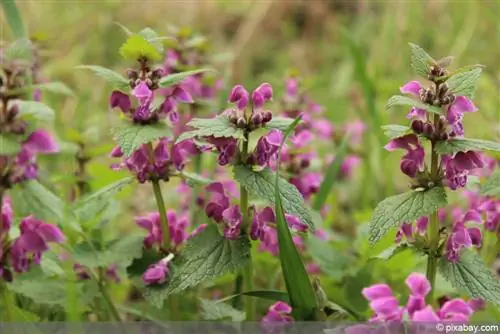
With blue and purple forest flowers, it is often difficult to define whether the flower is blue or purple. If it is not obvious, as with the fragrant violet or the liverwort, the individual species can be easily confused. The European cyclamen is one of the most poisonous flowers you can find in the Alpine region. It is protected in Bavaria and should never be picked yourself as the effect can be life-threatening. The spotted lungwort is an old medicinal herb and is often picked and given as gifts due to its flower shape, which resembles a calyx, and its intense color. Blue and purple forest flowers are visible within a few moments in the forest and they are often one of the species that thrive in partial shade or shade. Of course, the fragrant violet should not be forgotten here, which was consecrated to deities in ancient times because it has an extremely intense scent that made it a love flower.
- Spotted lungwort (Pulmonaria officinalis)
- Scented Violet (Viola odorata)
- Forest cranesbill (Geranium sylvaticum)
- Creeping Gunsel (Ajuga reptans)
- Gundel vine (Glechoma hederacea)
- Swamp skullcap (Scutellaria galericulata)
- Gamander Speedwell (Veronica chamaedrys)
- Purple Orchid (Orchis purpurea)
- Hollow Larkspur (Corydalis cava)
- Liverwort (Anemone hepatica)
- European cyclamen (Cyclamen purpurascens)
Forest flowers in reddish colors
Flowers in reddish tones can be seen from afar by their flowers, which, like the red foxglove, are found on a shoot that stretches up away from the leaves. It is the most common foxglove species in Europe and is also an extremely poisonous plant, with all parts of the plant being poisonous. Nevertheless, due to its red, almost purple color, it attracts many enthusiasts who photograph the plant. One of the most famous reddish forest flowers is the narrow-leaved willowherb.

Through the plant, the German botanist Christian Konrad Sprengel was able to observe the concept of cross-pollination in the 18th century, which led to a better understanding of the entire plant world. The Immenblatt is the only representative of this genus and has chosen a location in deciduous forests with precious woods. The immen leaf is popular because of its sweet scent, which primarily attracts bees and bumblebees. They even smell like honey.
- Red foxglove (Digitalis purpurea)
- Comfrey (Symphytum officinale)
- Red Campion (Silene dioica)
- Immenblatt (Melittis melissophyllum)
- Narrow-leaved fireweed (Chamerion angustifolium)
- Purple deadnettle (Lamium purpureum)
Forest flowers in yellow
It appears yellow in the forest. Yellow flowers are probably one of the most diverse groups when it comes to colored flowers that can be found in the forest. When taking a walk in the forest, it is worth looking at trees, under ferns and other corners of the forest, as some of these specimens may be hiding here. The following forest flowers are all found in German forests and many of them are very popular and known to everyone. The best example here is the cowslips, which can be found in several species in the forests, especially the high cowslip.
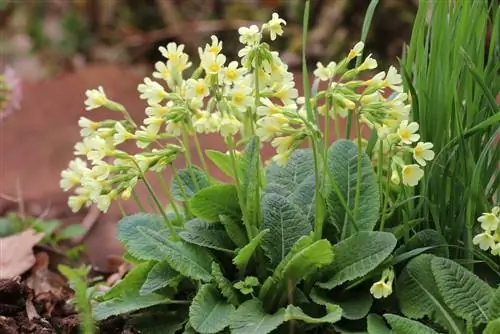
It is a so-called harbinger of spring and can be found as early as March in riparian forests and stream edges that run through these forests. Of course, we shouldn't forget the forest gold star, which attracts attention with its bright flowers. Another representative of this category are the popular yellow anemones, which, like the wood anemones, stand out thanks to their large petals.
- Primrose (Primula veris)
- Tall cowslip (Primula elatior)
- Golden buttercup (Ranunculus auricomus)
- Yellow anemone (Anemone ranunculoides)
- Forest yellow star (Gagea lutea)
- Celandine (Chelidonium majus)
- Rose lettuce (Aposeris)
- Spurge family (Euphorbiaceae)
- Small Balsam (Impatiens parviflora)
- Great Balsam (Impatiens noli-tangere)
- Meadow quail wheat (Melampyrum pratense)
- Common loosestrife (Lysimachia vulgaris)
- Pennigwort (Lysimachia nummularia)
- Golden nettle (Lamium galeobdolon)
- Forest hawkweed (Hieracium murorum)
- Cloveroot (Geum urbanum)
- Figwort (Ficaria verna)
- Swamp marigold (C altha palustris)
- Yellow violet (Viola biflora)
Multicolored Forest Flowers
One of the few forest flowers that comes in multiple colors without having a primary tone is the Helleborus. Helleborus is also known as hellebores and snow roses and this cockleworm plant can be found from Europe to Asia. They stand out because of their rather large leaves and also have five petals that range from red to purple to white and green. The Christmas rose, another name for Helleborus, occurs in these numerous colors and also in other types that can be found in Germany and Europe. Also among the multicolored flowers are the lovely elf flowers, Epimedium. The barberry family immediately catches the eye with its uniquely shaped flowers, which are curved in an elegant shape and really look fantastic.
Forest flower habitat
The native forest flowers are all distributed throughout the forests, which are mainly found in Central Europe and the Alpine region. Due to their diversity, every walk in summer and spring is characterized by the aromas and colors of these plants, which are not only used in medicine and cuisine, but have also inspired artists of all eras. If you are looking for a specific flower, it is worth finding the necessary information about the preferred location beforehand. Some flowers are only found near water and deciduous forests, while the red foxglove, for example, thrives particularly well in newly planted coniferous forests. But if you are not sure which of these plants you are looking for, it is worth simply going into nature and looking for interesting specimens along the forest paths. By choosing the right color, you can easily find the necessary information about the plant.
Protected plants
Before you pick one of the forest flowers, you should be sure whether this flower is protected. Many of the species mentioned above are controlled and are either on the endangered species list or are protected for other reasons. Wild garlic is one of those plants that shouldn't just be picked. Regardless of whether you want to hang the flower as a spice or to dry, this is not permitted.
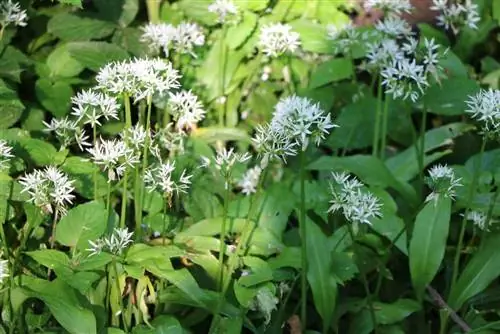
If the plant is not an herb and is only used for decoration, you can only pick a small bouquet that fits between your thumb and forefinger. This prevents large quantities of plants from simply being stolen, as they usually provide a basis for bees, insects, birds and mammals in some form. Be careful not to pick flowers in national parks. There is always a ban on picking plants here and even if the temptation is great, this can lead to legal problems.
Popular forest flowers
The most popular forest flowers include violets. Because of their numerous species with their intense scent, they are often brought into one's own garden and delight as soon as they are discovered on the side of the road. In addition to the violets, the primroses, which everyone probably remembers from childhood, are also impressive. They have a high proportion of ingredients that have a positive effect on he alth. The spring knot flower is known throughout Germany thanks to its other name, Märzenbecher. This flower is found in many mixed and riparian forests and is also protected and poisonous. It is noticeable in early spring and often breaks out from under the snow cover to face the new sun.

